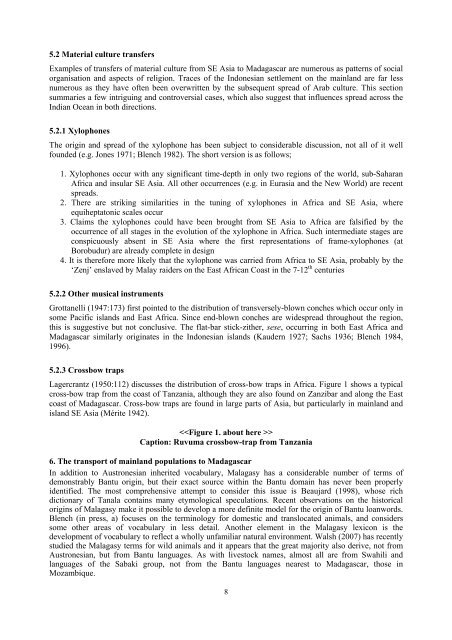Paper for Cambridge 2007 proceedings submit.pdf - Roger Blench
Paper for Cambridge 2007 proceedings submit.pdf - Roger Blench
Paper for Cambridge 2007 proceedings submit.pdf - Roger Blench
Create successful ePaper yourself
Turn your PDF publications into a flip-book with our unique Google optimized e-Paper software.
5.2 Material culture transfers<br />
Examples of transfers of material culture from SE Asia to Madagascar are numerous as patterns of social<br />
organisation and aspects of religion. Traces of the Indonesian settlement on the mainland are far less<br />
numerous as they have often been overwritten by the subsequent spread of Arab culture. This section<br />
summaries a few intriguing and controversial cases, which also suggest that influences spread across the<br />
Indian Ocean in both directions.<br />
5.2.1 Xylophones<br />
The origin and spread of the xylophone has been subject to considerable discussion, not all of it well<br />
founded (e.g. Jones 1971; <strong>Blench</strong> 1982). The short version is as follows;<br />
1. Xylophones occur with any significant time-depth in only two regions of the world, sub-Saharan<br />
Africa and insular SE Asia. All other occurrences (e.g. in Eurasia and the New World) are recent<br />
spreads.<br />
2. There are striking similarities in the tuning of xylophones in Africa and SE Asia, where<br />
equiheptatonic scales occur<br />
3. Claims the xylophones could have been brought from SE Asia to Africa are falsified by the<br />
occurrence of all stages in the evolution of the xylophone in Africa. Such intermediate stages are<br />
conspicuously absent in SE Asia where the first representations of frame-xylophones (at<br />
Borobudur) are already complete in design<br />
4. It is there<strong>for</strong>e more likely that the xylophone was carried from Africa to SE Asia, probably by the<br />
‘Zenj’ enslaved by Malay raiders on the East African Coast in the 7-12 th centuries<br />
5.2.2 Other musical instruments<br />
Grottanelli (1947:173) first pointed to the distribution of transversely-blown conches which occur only in<br />
some Pacific islands and East Africa. Since end-blown conches are widespread throughout the region,<br />
this is suggestive but not conclusive. The flat-bar stick-zither, sese, occurring in both East Africa and<br />
Madagascar similarly originates in the Indonesian islands (Kaudern 1927; Sachs 1936; <strong>Blench</strong> 1984,<br />
1996).<br />
5.2.3 Crossbow traps<br />
Lagercrantz (1950:112) discusses the distribution of cross-bow traps in Africa. Figure 1 shows a typical<br />
cross-bow trap from the coast of Tanzania, although they are also found on Zanzibar and along the East<br />
coast of Madagascar. Cross-bow traps are found in large parts of Asia, but particularly in mainland and<br />
island SE Asia (Mérite 1942).<br />
<br />
Caption: Ruvuma crossbow-trap from Tanzania<br />
6. The transport of mainland populations to Madagascar<br />
In addition to Austronesian inherited vocabulary, Malagasy has a considerable number of terms of<br />
demonstrably Bantu origin, but their exact source within the Bantu domain has never been properly<br />
identified. The most comprehensive attempt to consider this issue is Beaujard (1998), whose rich<br />
dictionary of Tanala contains many etymological speculations. Recent observations on the historical<br />
origins of Malagasy make it possible to develop a more definite model <strong>for</strong> the origin of Bantu loanwords.<br />
<strong>Blench</strong> (in press, a) focuses on the terminology <strong>for</strong> domestic and translocated animals, and considers<br />
some other areas of vocabulary in less detail. Another element in the Malagasy lexicon is the<br />
development of vocabulary to reflect a wholly unfamiliar natural environment. Walsh (<strong>2007</strong>) has recently<br />
studied the Malagasy terms <strong>for</strong> wild animals and it appears that the great majority also derive, not from<br />
Austronesian, but from Bantu languages. As with livestock names, almost all are from Swahili and<br />
languages of the Sabaki group, not from the Bantu languages nearest to Madagascar, those in<br />
Mozambique.<br />
8

















